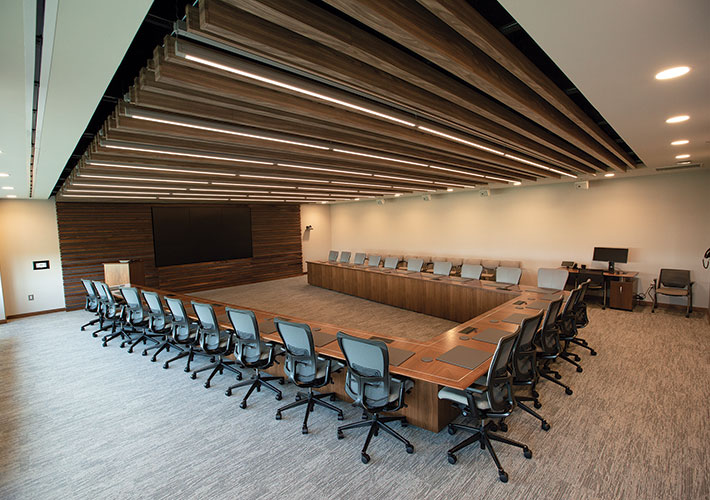
Standards Freshen Up ASTM International Headquarters
The ASTM International headquarters building in West Conshohocken, Pennsylvania, is in the midst of a makeover. As a start, the building’s first and fourth floors were renovated in the last 12 months, using ASTM’s own standards in the process.
In the 23 years since headquarters was built, “The work has changed and the way we work has changed, so we needed a freshening of the building,” said Philip Lively, ASTM’s vice president of finance and administration. “And it’s great to see how our own standards are actually used to make it happen.”
The architectural firm, Kimmel Bogrette Architecture + Site, based in Blue Bell, Pennsylvania, and general contractor Formcraft, based in Philadelphia, carried out the first phase of the project.
Formcraft’s construction superintendent John Chadwick said that his team took standards into consideration before the start of the project. He noted that the use of ASTM standards was discussed in the design and specification writing stages.
“We rely on [standards] to keep things safe while assuring that inferior and unsafe materials are not being manufactured or used on our projects,” says Chadwick. “Improper safety or poor products can become the greatest cost on any project if things go wrong.”
Both Formcraft and Kimmel Bogrette cited several standards used in this project:
- Specifications such as nonstructural steel framing members (C645) and gypsum board or drywall (C1396),
- Test methods such as surface burning characteristics of building materials (E84) and friction tapes (D69), and
- Terminology relating to occupational health and safety (E1542).
“As a project manager, the knowledge that the vast majority of products being used on this project have undergone rigorous testing to meet a certain standard is reassuring,” says Formcraft’s Wes Macdonald. “It gives us confidence in the work that’s being completed — that it has a high level of quality not subject to deterioration.”
Sherri Kimmel, associate and senior project manager of Kimmel Bogrette, added that architects rely heavily on ASTM specifications and other standards to ensure that products from various manufacturers can be used and trusted.
“This could range from building materials that meet code requirements or government regulations, to standards we rely on to ensure a product is uniform and consistent in design, construction, or maintenance requirements,” says Kimmel.
On completion of the first phase of renovation, ASTM International’s Information Technology division on the first floor was expanded to include open collaboration spaces, a large conference room, four huddle rooms, and two Skype rooms. Updated HVAC equipment and new LED lighting were also installed.
The fourth floor, which many ASTM International members use for meeting spaces, received an expanded and modernized board room with updated technology, an expanded banquet room, new lounges, and two Skype rooms. Movable partitions were also replaced to provide better acoustic privacy when adjacent meeting rooms are used simultaneously.
In the future, staff and visitors can expect to see improvements made in the first-floor lobby with a new reception desk, fresh branding, updated HVAC (heating, ventilation, and air conditioning) equipment, new LED lighting and technology, and improved acoustics to reduce noise levels, enhanced security features, and more.
Enhancements will also be made to the second and third floors in the next phase of the renovation.
Clearly, this renovation allows the architects, ASTM employees, and visitors from around the world to directly see the importance that standards have on major projects. ASTM International standards are widely used around the world, and it’s inspiring to see them being put to work within ASTM’s own spaces.
Call for Historical/Testing Objects
Do you have a cool object related to ASTM International standards — present or past? Perhaps a small testing machine or sample, or a product that conforms to our standards?
We are developing a display of such items in a newly-designed area of our global headquarters. If you would be willing to donate an item on a permanent or temporary basis, snap a picture and send it here, along with a few sentences about the size and purpose of the item, including its relationship to an ASTM standard.
All entries are due by July 31.
Emma Kuliczkowski, a journalism major at Temple University, is the 2018 Corporate Communications intern.
 SN Home
SN Home Archive
Archive Advertisers
Advertisers Masthead
Masthead RateCard
RateCard Subscribe
Subscribe Email Editor
Email Editor